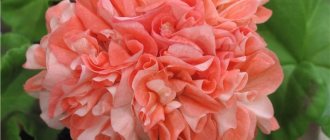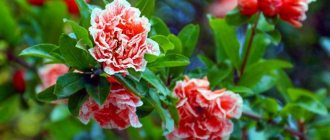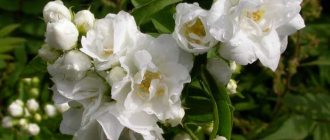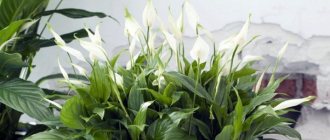The color red symbolizes energy, beauty and love. Therefore, since ancient times, flowers in fiery shades have always been woven into wreaths and planted in flower beds. Times have changed, but this color is still popular in garden design. It is actively used to complement flower beds, make bright accents on the site, and highlight landscape areas. We suggest studying the best red perennials, which stand out for their originality, can harmoniously complement the territory, and add bright accents to the area.
Low growing perennials with red flowers
Low-growing garden crops look great in borders, complementing paths or alleys. These flowers will be a creative option to complement the rest and relaxation area. Let's consider the most interesting options for low-growing crops that will harmoniously fit into any flower bed.
Spring Primrose
These flowers greet us with the first warmth. They truly symbolize spring and provide lush blooms. The bushes are distinguished by wrinkled, wavy leaves covered with hairs. Often primrose is also called “keys”. Traditionally, primrose blooms with yellow buds, but there are many varieties with red petals. The most popular is the Chinese primrose, which has red-brown peduncles. The crops prefer light types of soil and can be propagated by different methods - seed, cuttings, and dividing the bush.
For comfortable growth of bushes, you need to make a distance of 15 centimeters between them. The height of such beauties reaches up to 10-30 cm. Primrose will bloom within a month, starting from April and ending in May.
You might be interested
Decorative liana Ipomoea: cultivation and use in garden design
Red perennials: the best plants to grow in the garden
List of the best blue flowers and plants with blue foliage
Blood Red Cinquefoil
A beautiful perennial with red flowers is blood red cinquefoil. Its height is up to 0.6 meters. The culture is distinguished by straight, branched stems. The leaves are usually trifoliate in shape and have a dull green color on top. This culture is valued due to its flowers of incredible beauty. Their color is usually a brilliant red hue, up to 5 cm in diameter, they form paniculate or corymbose buds. Flowering is long - up to 50 days.
There are a large number of hybrids - among them "Gibson Scarlet", which is distinguished by scarlet-red petals with a slight shiny tint. You can see abundant flowers during June-July.
Border Chrysanthemums
Excellent red perennial flowers are border varieties of chrysanthemums. In gardening, such varieties are also called “Korean” or “Chinese”. These crops are distinguished by the fact that they are resistant to cold conditions and will delight you with long-lasting flowering. Border varieties are considered crumb flowers, which do not reach more than 0.3 meters in height, and independently form the ideal outline of a bush in the form of a ball. “Talisman” is considered the best varieties. These flowers have a bright color in raspberry-beet tones. The “Evening Lights” variety also looks very attractive. With their dazzling flashes of scarlet petals, they will easily complement any area and create incredible holiday euphoria.
Peony thin-leaved
This culture delights many generations, but previously this non-double peony was better known as “Voronets”. Looking at it, it’s hard to believe that this is not an artificially bred representative of the fauna. Now it is an endangered species, so you won’t be able to go and dig up a new specimen right in the meadow, since it is protected by law. But it can be successfully purchased at garden centers. Despite the rather high price, after purchase, a thin-leaved peony can be grown for many years, and the bush can be periodically divided and replanted.
The natural habitat of this field plant is the flat areas from the Dnieper to the Volga and the southern foothills of the Caucasus. In the wild, it is a dense bush with openwork carved leaves, dotted with red buds of non-double inflorescences in spring. After flowering, the red petals fade and the decorative effect disappears, so often when growing greenery in gardens, they are not allowed to stand the whole summer, but are cut off soon after withering.
The thin-leaved peony requires periodic division and planting of the bush.
A couple of years after transplantation, just like a garden peony, the plant gains strength, and only in the second or third year is it able to form many red buds. With an excess of nutrients, flowering may be inhibited.
Tall perennials with red flowers
If we have figured out the formation of borders, now we should think about how large areas on the site and mixborders will be decorated. The ideal solution in this case would be to use tall representatives with fiery petals. Let's look at the brightest red perennials.
Heleniums or red chamomile perennials
Helenums are tall red perennials that belong to the Asteraceae family. The homeland of such cultures is considered to be the territory of Eastern America. The height of specimens can reach up to 1.6 meters. The stem can be smooth, branched or straight. The leaves are usually lanceolate in shape and do not develop chaotically, but in order of priority.
Helenium usually forms a hemisphere, enveloped in yellow pollen. The central part is framed by circular petals. Visually, they resemble chamomile, hence the second name for heleniums.
Stem height up to 0.9 meters. Flowering can be observed within 5-6 weeks. These perennials will delight you with their fiery flowers from late summer to early autumn. When flowering ends, cylindrical seeds will form on the plant. In order for the bushes to develop beautifully and fully, they need to be watered abundantly and the soil well fertilized.
Exquisite Adonis or Adonis
Adonis is a red perennial that can also be grown as an annual. The plant is actively used in landscape design and has a wide range of healing properties. Therefore, the culture is listed in the International Red Book.
Adonis forms exquisite bushes that are distinguished by their lush appearance. The petals are fiery red in color, visually similar to chamomile. This flower is up to 3 cm in diameter. The total number of species is up to 32. Flowering lasts throughout the whole summer. To grow adonis, it is recommended to choose illuminated areas; the soil can be any kind. If the weather is excessively hot, additional watering of the bushes will be required.
Refined red garden perennial - Poppy
Poppy is a plant that has been familiar to many since childhood. But now, in addition to the usual variety, there are also decorative ones, with terry leaves. The height of the crops is up to 1.2 meters. To make poppies bloom continuously, you need to sow them every 10 days.
These red perennials have narrow leaves with small teeth along the edges. The flowers are created from 4 petals with two sepals. A tap root that goes deep into the ground. For growing poppies, it is better to choose areas with good lighting. Caring for the crop is not burdensome, the main thing is that it does not grow in areas with stagnant moisture or close groundwater.
Original Astilbe
Another red perennial is astilbe. These are herbaceous crops that belong to the Saxifraga family. There are more than 40 varieties of the plant, as well as about 400 cultivars. Astilbe height is up to 2 meters. The flowers form very sophisticated and attractive panicle-shaped inflorescences. Their length is up to 0.6 meters. The color varies, but the red buds deserve special attention. The Japanese astilib Montgomery is distinguished by such beauty. The height of the bushes is up to 0.7 meters, the leaves are usually reddish-brown in color. This beauty begins to bloom in the second half of July, this period lasts for 2 weeks.
When planting astilbes, remember that they do not need a lot of light rays; the ideal solution would be to plant them in light shade. This guarantees long-lasting and abundant flowering.
Lychnis chalcedony
For those looking for interesting and unusual perennials that bloom with red flowers, the sophisticated Lychnises have been bred. These crops belong to the Carnation family and are widespread throughout the Northern Hemisphere. These are rhizomatous plants, distinguished by the presence of an erect stem, its height is up to 1 meter. The leaves are oblong and create a rosette. Such crops bloom from the beginning of summer; the flowers have a thyroid shape. The corolla has a diameter of up to 2 centimeters.
Red perennials will delight you with their flowering for a month. The most popular variety with red petals is Lychnis chalcedony. Its height is up to 1 meter. Representatives have leaves of an erect type, with weak branching.
Composition ideas
Compositions from one plant, presented in different shades, look good , but more often they choose two flowers in order to emphasize not only the difference in color, but also the texture.
An extremely cute duet of similar plants of different sizes:
- white garden roses and red bush roses;
- white lilies and red alstroemeria.
Don't be afraid to add greens. It fits perfectly into the red and white combination, without weighing it down at all.
To make the bouquet look perfect, you should take into account the bride’s appearance:
- cascading compositions are suitable for tall girls;
- low – round or spherical shape;
- For plump brides, it is better to choose voluminous, airy compositions;
- slender – miniature and elongated.
Consider the decor of the dress. If it is luxurious, then let a modest bouquet complement it, and not enter into a dispute over the place of the main accent. Simple styles allow you to play with flower decorations.
Roses
Roses are royal flowers, a symbol of love and devotion. A huge number of varieties - with large or miniature, elongated or casually fluffy buds - allow you to create a variety of compositions from these plants: from the most luxurious to elegantly natural.
The simplest, but no less sensual option is a round bouquet of roses of the same variety, but in different shades. In this case, white can be placed along the edges, in the center, and in the case of buds tightly pressed to each other, a variety of patterns can be created. You can add a touch of red, for example, make a bouquet with red and white garden varieties and pink bush varieties.
The mixture of bush and garden roses in one bouquet looks interesting, and it does not matter at all which variety appears in red. You can make a composition from different varieties of roses with inflorescences similar in structure, but very different in size - such an ensemble is charming.
If you want to add a little vintage charm, then take a closer look at the David Austin peony roses. Their cup-shaped, delicate buds look great with both bush and garden brethren.
Important! It is not at all necessary to maintain an equal volume of shades. White or red are worthy of acting as small contrasting accents on the monochrome of the second contrasting tone.
Greenery will make the composition fresher. Leaves and stems completely hidden by decoration are also possible. The choice depends on the overall image and your wishes. An excellent option for tall brides is a cascade of white and red roses, in which the flowers seem to flow down the fluffy openwork greenery.
Callas and tulips
An interesting picture is created by a non-standard combination of exotic calla lilies, full of aristocratic grace, and simple sensual tulips.
Since both plants have powerful, long and succulent stems, the composition is most often made in the form of a scepter - long and rather narrow. Such an accessory looks best in the hands of a tall bride, while short ones can take a closer look at mini calla lilies or other forms.
Most often, snow-white callas are surrounded by scarlet or burgundy tulips - the result is a very sublime feminine picture. The opposite solution is also possible - red callas and delicate white tulips. Such a non-standard combination will definitely not leave anyone indifferent.
Callas are ideal for additional decoration. Thus, pearls of the opposite color inserted into each bud look stylish. The mother-of-pearl silver of pearls allows you to create a complete picture.
Freesia
White graceful freesia petals create a wonderful airy background for the queen of flowers, on which she can shine in all her glory.
White freesias, delicate and pure, are most often used, but for a more sensual composition you can also take red ones , since the plant is presented in a huge palette of shades.
Advice! Add greenery to the bouquet. It will not deprive the composition of its elegance, but will make it more touching.
Another interesting option is a bouquet consisting of roses, in which freesias act as small terry accents.
Red perennials blooming all summer
If you really want, you can find those perennials that will delight you with abundant and long flowering throughout the summer. The most popular flower that can provide this effect is begonia. This culture does not need any special introduction, because it is known and appreciated due to its bright and lush flowering.
The most popular variety is Regal Minuet. The color plates are usually pearl-cherry shades, with a brownish-red spider visible in the center. The edges have a dark red border.
Another representative that will delight you with flowering from June to September is red valerian or centranthus. The bush can reach up to 0.6 meters in diameter. The most popular variety is Coccineus.
To grow valerian on your site, give preference to warm, sunny places that will not be exposed to draft winds. The ideal solution for growing would be planting in rock gardens and rocky gardens. Valerian is propagated by seed through seedlings or by dividing the bush.
Amaranth spicata
Amaranth is considered a weed, but it is also actively grown in homesteads. Initially, its homeland was America, and several centuries ago its seeds came to Europe, and it spread to many countries.
The leaf blades can be dark green or purple, the underground root has a pinkish tint. It grows as an annual plant that can reach a height of one meter. The culture is actively used as a medicinal plant. It is used for digestive disorders and as a hemostatic component of medications.
In addition, amaranth is used as a forage crop, which promotes the rapid growth of rabbits, nutria and livestock. Recently, this multifaceted flower has become increasingly popular as a culinary ingredient. Salads are prepared from amaranth, it is used in soups, as part of stewed vegetables, etc.
Perennials with red foliage
The original red perennials are those that do not have fiery-colored flowers, but leaves. They are able to complement any flower bed, making it more rich and presentable. The most popular are:
Blood red Heuchera
The leaves of this garden crop are distinguished by reddish-green shades.
The plant is ideal for combination with various decorative plantings in green tones.
Extravagant Coleus
This culture looks great in garden beds, various flower beds, and containers.
A very decorative Coleus Blume, which has large-toothed burgundy leaves. Crimson Ruffles also looks beautiful with raspberry-burgundy leaves.
Amaranth
These plants are an ideal solution for planting next to ornamental cabbage.
They prefer light, fertile soils and perfectly complement various types of garden plots.
Red perennials are flowers that will add a pop of color to any area. If you choose undemanding but presentable plants, you will be able to form unrealistic compositions that will make any area extraordinary and sophisticated.











